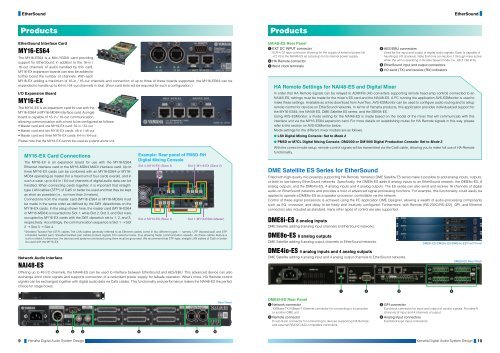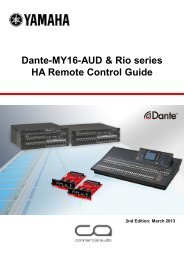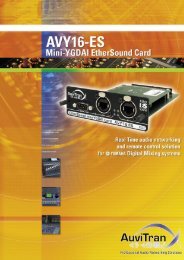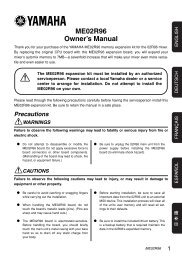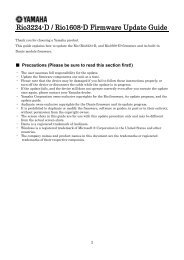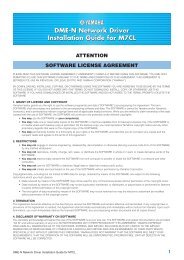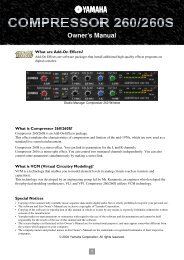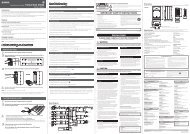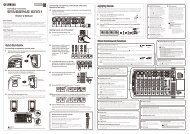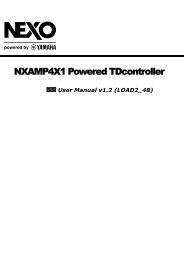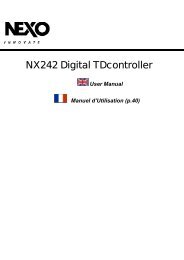Yamaha Digital Audio System Design Guide 8.42MB
Yamaha Digital Audio System Design Guide 8.42MB
Yamaha Digital Audio System Design Guide 8.42MB
You also want an ePaper? Increase the reach of your titles
YUMPU automatically turns print PDFs into web optimized ePapers that Google loves.
9<br />
EtherSound EtherSound<br />
Products<br />
EtherSound Interface Card<br />
MY16-ES64<br />
The MY16-ES64 is a Mini-YGDAI card providing<br />
support for EtherSound In addition to the 16-in /<br />
16-out channels of audio handled by this card,<br />
MY16-EX expansion boards can also be added to<br />
further boost the number of channels. With each<br />
MY16-EX adding a maximum of 16-in / 16-out channels and connection of up to three of these boards supported, the MY16-ES64 can be<br />
expanded to handle up to 64-in / 64-out channels in total. (Four card slots will be required for such a confi guration.)<br />
I/O Expansion Board<br />
MY16-EX<br />
The MY16-EX is an expansion card for use with the<br />
MY16-ES64 or MY16-MD64 interface card. A single<br />
board is capable of 16-in / 16-out communication,<br />
allowing communication with a host to be confi gured as follows:<br />
• Master card and one MY16-EX card: 32-in / 32-out<br />
• Master card and two MY16-EX cards: 48-in / 48-out<br />
• Master card and three MY16-EX cards: 64-in / 64-out<br />
Please note that the MY16-EX cannot be used as a stand-alone unit.<br />
MY16-EX Card Connections<br />
The MY16-EX is an expansion board for use with the MY16-ES64<br />
Ethernet interface card or the MY16-MD64 MADI interface card. Up to<br />
three MY16-EX cards can be combined with an MY16-ES64 or MY16-<br />
MD64 operating as master (for a maximum of four cards overall), and in<br />
such a case, up to 64-in / 64-out channels of digital audio data can be<br />
handled. When connecting cards together, it is important that straighttype<br />
LAN cables (STP*) of Cat5 or better be used and that they be kept<br />
as short as possible (i.e., no more than 3 meters).<br />
Connections from the master card (MY16-ES64 or MY16-MD64) must<br />
be made in the same order as defi ned by the SW1 dipswitches on the<br />
MY16-EX cards. In the setup shown here, the master card (MY16-ES64<br />
or MY16-MD64) is inserted into Slot 1, while Slot 2, Slot 3, and Slot 4 are<br />
occupied by MY16-EX cards with the SW1 dipswitch set to 1, 2, and 3,<br />
respectively. Accordingly, the communication sequence is Slot 1 ➝ Slot<br />
2 ➝ Slot 3 ➝ Slot 4.<br />
*Shielded Twisted Pair (STP) cables The LAN cables generally referred to as Ethernet cables come in two different types — namely, UTP (twisted pair) and STP<br />
(shielded twisted pair). Shielded twisted pair cables protect signals from external noise, thus allowing faster communication speeds. As these cables feature a<br />
built-in shield, furthermore, the devices and systems connected using them must be grounded. We recommend that STP-type, straight LAN cables of Cat5 or better<br />
be used with the MY16-EX.<br />
Network <strong>Audio</strong> Interface<br />
NAI48-ES<br />
Offering up to 48 I/O channels, the NAI48-ES can be used to interface between EtherSound and AES/EBU. This advanced device can also<br />
exchange word clock signals and supports connection of a redundant power supply for failsafe operation. What’s more, HA Remote control<br />
signals can be exchanged together with digital audio data via Cat5 cables. This functionality and performance makes the NAI48-ES the perfect<br />
choice for stage boxes.<br />
1 2 3 4 5 6<br />
<strong>Yamaha</strong> <strong>Digital</strong> <strong>Audio</strong> <strong>System</strong> <strong>Design</strong><br />
Example: Rear panel of PM5D-RH<br />
<strong>Digital</strong> Mixing Console<br />
Slot 4: MY16-EX (Slave 3)<br />
Slot 2: MY16-EX (Slave 1)<br />
Slot 3: MY16-EX (Slave 2)<br />
Slot 1: MY16-ES64 (Master)<br />
Rear Panel<br />
Products<br />
NAI48-ES Rear Panel<br />
1 EXT DC INPUT connector<br />
XLR-4-32 type connector allowing for the supply of external power (at<br />
+12 V) to the NAI48-ES as a backup for its internal power supply.<br />
2 HA Remote connector<br />
3 Word clock terminals<br />
HA Remote Settings for NAI48-ES and <strong>Digital</strong> Mixer<br />
In order that HA Remote signals can be relayed to AD8HRs (AD converters supporting remote head-amp control) connected to an<br />
NAI48-ES, settings must be made for the mixer’s ES card and the NAI48-ES. A PC running the application AVS-ESMonitor is used to<br />
make these settings. Available as a free download from AuviTran, AVS-ESMonitor can be used to confi gure audio routing and to setup<br />
remote control for devices on EtherSound networks. In terms of <strong>Yamaha</strong> products, this application provides individualized support for<br />
the MY16-ES64, the NAI48-ES, DME Satellite ES series, and the SB168-ES.<br />
Using AVS-ESMonitor, a mode setting for the NAI48-ES is made based on the model of the mixer that will communicate with this<br />
interface unit via the MY16-ES64 expansion card. For more details on establishing routes for HA Remote signals in this way, please<br />
refer to the section on AVS-ESMonitor below.<br />
Mode settings for the different mixer models are as follows.<br />
● LS9 <strong>Digital</strong> Mixing Console: Set to Mode 2<br />
● PM5D or M7CL <strong>Digital</strong> Mixing Console; DM2000 or DM1000 <strong>Digital</strong> Production Console: Set to Mode 3<br />
With the correct mode setup, remote-control signals will be transmitted via the Cat5 cable, allowing you to make full use of HA Remote<br />
functionality.<br />
DME Satellite ES Series for EtherSound<br />
Fitted with high-quality mic preamps supporting HA Remote, <strong>Yamaha</strong>’s DME Satellite ES series make it possible to add analog inputs, outputs,<br />
or both to low-latency EtherSound networks. Specifi cally, the DME8i-ES adds 8 analog inputs to an EtherSound network; the DME8o-ES, 8<br />
analog outputs; and the DME4io-ES, 4 analog inputs and 4 analog outputs. The ES series can also send and receive 16 channels of digital<br />
audio on EtherSound networks and provides a host of advanced signal-processing functions. For example, this functionality could easily be<br />
applied to operate a DME8o-ES as a speaker processor, controllable via the network.<br />
Control of these signal processors is achieved using the PC application DME <strong>Design</strong>er, allowing a wealth of audio-processing components<br />
such as EQ, crossover, and delay to be freely and intuitively confi gured. Furthermore, with Remote (RS-232C/RS-422), GPI, and Ethernet<br />
connectors also included as standard, many other types of control are also supported.<br />
DME8i-ES 8 analog inputs<br />
DME Satellite adding 8 analog input channels to EtherSound networks.<br />
DME8o-ES 8 analog outputs<br />
DME Satellite adding 8 analog output channels to EtherSound networks.<br />
DME4io-ES 4 analog inputs and 4 analog outputs<br />
DME Satellite adding 4 analog input and 4 analog output channels to EtherSound networks.<br />
DME8i-ES Rear Panel<br />
1 Network connector<br />
100Base-TX/10Base-T Ethernet connector for connecting to a computer<br />
or another DME unit.<br />
2 Remote connector<br />
D-sub 9-pin connector for connecting to devices supporting HA Remote<br />
and external RS232C/422 compatible controllers.<br />
4 AES/EBU connectors<br />
Used for the input and output of digital audio signals. Each is capable of<br />
handling 8 I/O channels. Note that only connectors 1 through 4 are active<br />
when the unit is operating in Double Speed mode (i.e., 88.2 / 96 kHz).<br />
5 EtherSound input and output connectors<br />
6 I/O send (TX) and receive (RX) indicators<br />
DME8i-ES/DME8o-ES/DME4io-ES Front Panel<br />
1 2 3 4<br />
DME8i-ES Rear Panel<br />
3 GPI connector<br />
Euroblock connector for input and output of control signals. Provides 8<br />
channels of input and 4 channels of output.<br />
4 Analog input connectors<br />
Euroblock-type input connectors.<br />
<strong>Yamaha</strong> <strong>Digital</strong> <strong>Audio</strong> <strong>System</strong> <strong>Design</strong> 10


